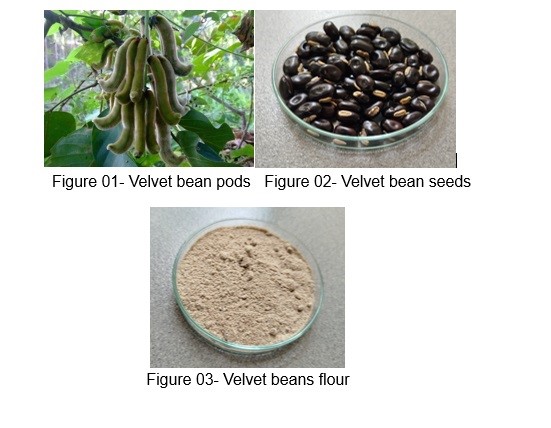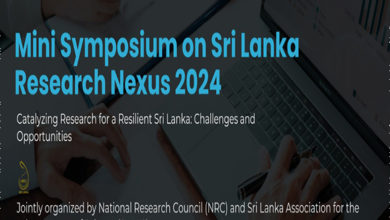Enhancing Protein Security in Sri Lanka through the Development of Protein-Rich Nutritional Food Products from an Underutilized Legume Crop
Dr. Pradeep Gajanayake (Senior Lecturer) & Ms. Nayanathara Jayasingha (Research Assistant)

The economic crisis that occurred in Sri Lanka with the Corona pandemic had a huge impact on human life and its consequences are still being felt. Therefore, people including children focused on utilizing more carbohydrates instead of protein because of the inflated price of foods such as meat, fish, and eggs. The main problem that arose from this is the rapid increase in malnutrition among children. The price of protein-rich foods increased rapidly due to factors such as the increase in raw material prices in the world market and the economic recession in the country. Protein deficiency has arisen not only among children but also among the country’s workforce, pregnant mothers, and the elderly. As a result, many middle-class families and daily wage earners are cutting back on animal protein from their daily meals. Now many middle-class and daily-income families rely on plant protein because of their low price and easy accessibility. Sri Lanka relies heavily on imports of soybean meal to support its livestock and poultry industries, which play a crucial role in the nation’s agricultural sector. The majority of these imports are sourced from key producers such as India, Brazil, and the United States. This soybean meal serves as a vital source of protein and nutrients for livestock feed, helping to ensure the health and productivity of animals raised for meat, milk, and eggs. As demand for poultry and livestock products continues to rise in Sri Lanka, securing a stable supply of high-quality soybean meal becomes increasingly important for the country’s food security and economic growth.
The bodybuilding industry and athletes have been greatly affected by the economic crisis, especially in terms of their capacity to purchase necessary protein and other supplements. These supplements are used by many bodybuilders to fulfill their daily protein requirements, which are essential for performance, muscular building, and restoration. However, the affordability of these supplements has become a significant concern due to the depreciating currency. Athletes who were previously able to meet their nutritional requirements without financial restrictions have been driven to decrease their supplement intake, which has a negative impact on their physical development and training progress.
Lentils and legumes are valuable plant-based protein sources. Dhal, made from lentils, is a staple in Sri Lankan cuisine, often cooked with coconut milk and seasonings. Black beans and chickpeas are popular in curries and salads, offering protein and fiber. Soybeans and soy meat are commonly consumed by vegetarians, but using proper seasonings is essential for flavor. Sri Lanka should focus on sustainable and cost-effective protein alternatives, like underutilized legumes such as pigeon peas, velvet beans, and winged beans. These options have high nutritional value and low cultivation costs, helping to reduce reliance on imports. Velvet beans, commonly known as Wanduru maa (Mucuna pruriens), are a remarkable source of protein, making them a valuable addition to diets, especially in regions where protein deficiency is prevalent. In addition to their nutritional benefits, these beans are renowned for their medicinal properties. They have been used in traditional medicine for various purposes, including improving digestion, enhancing mood, and promoting overall well-being. The presence of bioactive compounds in velvet beans contributes to their health benefits, making them a versatile and important plant in both culinary and therapeutic contexts. Investing in local food processing and plant-based protein innovation can enhance food security and lower protein diet costs. Promoting these alternatives will support local farmers, improve nutrition, and create a self-sufficient food system (Vadivel & Janardhanan, 2000).
Velvet beans are a highly nutritious legume, containing 25-30% protein (Kalidass et al., 2014; Baby et al., 2023; Ezegbe et al., 2023) comparable to soybeans. They are also rich in essential amino acids, fiber, and bioactive compounds like L-Dopa, which provides neurological benefits. The seeds offer various health benefits, including management of diabetes, rheumatoid arthritis, Parkinson’s disease, atherosclerosis, fever, and pain. They are also used to address menstruation issues, constipation, edema, fever, and tuberculosis. Velvet bean seed powder helps infertile individuals by acting as a restorative tonic and aphrodisiac, improving sperm quality and functionality affected by stress. Research shows that infertile men have lower levels of dopamine, noradrenaline, and adrenaline in their seminal plasma and serum. The following table shows the nutrient composition contained in 100g of velvet beans (Ortega Monge et al., 2022).

The widespread adoption of velvet bean as a protein source could bring significant economic and agricultural benefits to Sri Lanka. Velvet beans are an adaptable crop that may thrive in a variety of environments. Although they need well-drained soil and may survive on poor, sandy, or degraded soils. Although they like 650 to 2,500 mm of rainfall, their drought tolerance allows them to live with less. Although they thrive in warm areas, temperatures between 15 and 35°C are adequate. Because they fix nitrogen in the soil, they do not require much fertilizer. Velvet beans are perfect for low-input farming systems since they can still grow and yield with little maintenance. Encouraging farmers to cultivate velvet beans could provide them with a new source of income, reduce reliance on imported crops, and strengthen national food security. As a nitrogen-fixing legume, velvet bean improves soil fertility, decreases the need for chemical fertilizers, and promotes sustainable farming practices. With adequate support from the government and agricultural authorities such as incentives, research funding, and policy development, this underutilized legume has the potential to become a vital part of Sri Lanka’s agricultural and nutritional landscape (Reshma. R et al., 2024; Siddhuraju & Becker, 2001).
A group of researchers at the Faculty of Technology, University of Sri Jayewardenepura, is exploring the development of protein-rich nutritional food products using velvet beans. One of the key innovations from this research is the refinement of processing techniques to ensure that velvet bean products are both safe and nutritious, given that they contain high levels of antinutrients. During this research, several methods were tested to remove antinutrients and increase the bioavailability of nutrients. Among them, the method which has a higher antinutrient reduction rate and is the most convenient method to use in the food industry was selected. The second stage of this research is the formulation of velvet bean-based protein bars, which provide a convenient and affordable protein source, particularly for athletes, students, and health-conscious individuals. This protein bar provides a double benefit for bodybuilders by integrating the increased protein content of velvet bean with the natural ability to enhance testosterone levels, thus facilitating muscle development and overall performance. These bars are made with velvet bean flour, nuts, seeds, and natural sweeteners to enhance their taste and nutritional value. Additionally, researchers are developing velvet bean-fortified flour for use in baking and cooking, offering a healthier alternative to traditional wheat flour. This fortified flour can be used in making bread, chapatis, and other staple foods, providing an easy route to increasing protein intake. Another promising development includes high-protein snacks and beverages, such as biscuits, energy drinks, and protein powders, aimed at making high-protein nutrition accessible to a broader audience. Since velvet beans have not traditionally been a common food source in Sri Lanka, raising awareness about their benefits and promoting their culinary versatility is essential. The food industry plays a vital role in incorporating velvet beans into commercially viable food products, which could help normalize their consumption among the general public.
As Sri Lanka faces increasing concerns about protein security and food sustainability, exploring underutilized crops like Velvet Bean presents a valuable solution. By investing in research, innovation, and agricultural development, the country can decrease its reliance on imported protein sources while ensuring that affordable and nutritious food options are accessible to all Sri Lankans. Integrating Velvet Bean into mainstream food products is not only a step toward improving national nutrition, but it also signifies a broader movement towards a more sustainable and self-sufficient future for Sri Lanka.

References
Baby, C., Kaur, S., Singh, J., & Prasad, R. (2023c). Velvet bean (Mucuna pruriens): A sustainable protein source for tomorrow. Legume Science, 5(3). https://doi.org/10.1002/leg3.178
Chinapolaiah, A., K., H. B., G.N., M., Thondaiman, V., Keshava Rao, V., N., H. R., & S., S. K. (2019). Variability in L-Dopa and other biochemical composition of Mucuna pruriens (L.) an underutilized tropical legume. Industrial Crops and Products, 138. https://doi.org/10.1016/j.indcrop.2019.06.010
Lampariello, L. R., Cortelazzo, A., Guerranti, R., Sticozzi, C., & Valacchi, G. (2011). The Magic Velvet Bean of Mucuna pruriens. In Journal of Traditional and Complementary Medicine (Vol. 1, Issue 4).
Ortega Monge, M. C., Salas, M. F. R., Chavarría-Rojas, M., Berrocal, G. C., & Redondo, G. M. (2022). Universal Aspects of the Genus Mucuna and the Properties Describe of Mucuna urens and Mucuna pruriens. Pharmacognosy Reviews, 16(32), 74–81. https://doi.org/10.5530/phrev.2022.16.11
Ezegbe, C. C., Nwosu, J. N., Owuamanam, C. I., Victor-Aduloju, T. A., & Nkhata, S. G. (2023). Proximate composition and anti-nutritional factors in Mucuna pruriens (velvet bean) seed flour as affected by several processing methods. Heliyon, 9(8). https://doi.org/10.1016/j.heliyon.2023.e18728
Kalidass, A., Mahapatra, C. and Bailey, L.H., 2014. Evaluation of the proximate and phytochemical compositions of an underexploited legume Mucuna pruriens var. utilis (Wall ex Wight). International Food Research Journal, 21(1), pp.191–195.
Reshma. R, Reshma. P, Shaik Nazir Basha, & Reddappa J.B. (2024). VELVET BEAN INSIHTS. In Beans an Insight study (Vol. 1, pp. 191–200).
Siddhuraju, P., & Becker, K. (2001). Preliminary nutritional evaluation of Mucuna seed meal (Mucuna pruriens var. utilis) in common carp (Cyprinus carpio L.) : an assessment by growth performance and feed utilisation. Aquaculture, 105–123.
Vadivel, V., & Janardhanan, K. (2000). Nutritional and anti-nutritional composition of velvet bean: an under-utilized food legume in South India.

Dr. Pradeep Gajanayake
Senior Lecturer,
Department of Biosystems Technology,
Faculty of Technology,
University of Sri Jayewardenepura.

Ms. Nayanathara Jayasingha
Research Assistant,
Department of Biosystems Technology,
Faculty of Technology,
University of Sri Jayewardenepura

